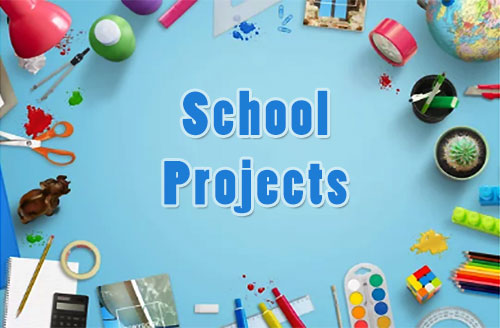A collection of creative school project ideas that elementary school students can use for their science projects, humanities projects or general homework projects. There are some high school project ideas as well, primarily in science subjects, like water conservation, which can also be conveniently used in school presentations. So scroll down, and explore the different project ideas listed below, categorized accordingto genre.
Some unique, modern science school project ideas that can pique students' interest and encourage exploration. These projects deal with the present day unique problems, mainly due to civilization and progress in science and technology.
Build a solar-powered oven using a cardboard box and aluminum foil to demonstrate the principles of solar energy and its applications in cooking.
Materials: Cardboard box, aluminum foil, black construction paper, plastic wrap, and a cooking thermometer.
Instructions: Line the inside of the box with aluminum foil and black construction paper to absorb heat. Cut a flap in the box lid and cover it with plastic wrap. Set up the box in direct sunlight and place food inside on a tray. Monitor the temperature rise using the cooking thermometer.
Set up a hydroponic garden to explore how plants can grow without soil and investigate the effects of different nutrient solutions on plant growth.
Materials: A large plastic container, net pots, clay pellets, nutrient solution, and plant seeds or seedlings.
Instructions: Fill the plastic container with the nutrient solution. Place net pots filled with clay pellets into the container. Plant seeds or seedlings in the net pots. Ensure the plant roots are submerged in the nutrient solution while providing adequate light for growth.
Create edible water bottles using sodium alginate and calcium lactate to explore sustainable alternatives to plastic bottles and their impact on the environment.
Materials: Sodium alginate, calcium lactate, water, and food-safe syringes.
Instructions: Create a sodium alginate solution and a calcium lactate bath. Fill the syringe with the sodium alginate solution and drop small droplets into the calcium lactate bath. The droplets will solidify into edible water bottles.
Research and design a product inspired by nature's solutions to human challenges, showcasing the concept of biomimicry.
Materials: Research materials like books, articles, and online resources for inspiration. Design software or art supplies for creating the product prototype.
Instructions: Research nature's solutions to a specific problem and identify key features to incorporate into the product design. Use design software or create a physical prototype to showcase the biomimetic product.
Build a water filtration system using readily available materials to demonstrate the process of water purification and its importance in addressing water scarcity.
Materials: Plastic bottles, sand, gravel, activated charcoal, cotton or coffee filters, and dirty water.
Instructions: Cut the plastic bottles to create a filtration system. Layer the bottles with sand, gravel, and activated charcoal to filter the water. Pour dirty water through the system and collect the filtered water to test its purity.
Design and construct an elaborate Rube Goldberg machine to demonstrate the transfer of energy and the complex interactions of simple machines.
Materials: Various household items like dominos, marbles, toy cars, ramps, and levers.
Instructions: Design a complex chain reaction using simple machines and household items. Assemble the Rube Goldberg machine, ensuring that each component triggers the next one in the sequence.
Conduct experiments to optimize the efficiency of wind turbine blades and explore the potential of wind energy as a renewable resource.
Materials: Cardboard, wooden dowels, paper cups, and a small motor or generator.
Instructions: Design and build different wind turbine blades using cardboard and attach them to the wooden dowels. Connect the motor or generator to the turbine and test each blade design to see which one produces the most power.
Investigate different materials that can be used to create biodegradable plastic and assess their effectiveness in reducing plastic pollution.
Materials: Various biodegradable materials like cornstarch, potato starch, and vegetable glycerin.
Instructions: Research different biodegradable materials and their properties. Mix the materials in varying ratios to create biodegradable plastic samples. Test the samples for strength, flexibility, and decomposition time.
Examine the influence of different genres of music on plant growth and determine if music can positively impact plant development.
Materials: Potted plants, music player, and speakers with different genres of music.
Instructions: Set up potted plants in identical conditions with the same amount of sunlight and water. Play different genres of music to each plant group for specific durations each day. Monitor plant growth and compare the results.
Set up a vermicomposting bin to study how worms can help decompose organic waste and produce nutrient-rich compost.
Materials: A large container with air holes, red worms, shredded paper, vegetable scraps, and soil.
Instructions: Layer shredded paper, vegetable scraps, and soil in the container. Add red worms to the mixture. Monitor the composting process and observe how worms help decompose organic waste.
Explore the concept of inertia using a Newton's cradle and investigate how the number of spheres affects the transfer of energy.
Materials: A Newton's cradle toy and additional steel balls.
Instructions: Add or remove steel balls from the Newton's cradle to investigate how the number of balls affects the transfer of energy and the motion of the system.
Analyze water samples for microplastics and study their prevalence in different water sources, raising awareness about microplastic pollution.
Materials: Water samples from different sources, microscope, petri dishes, and tweezers.
Instructions: Collect water samples from various sources and filter them to extract potential microplastics. Examine the filtered particles under a microscope and record the findings.
Investigate the growth of bacteria on smartphone screens and study the effectiveness of different cleaning methods to promote hygiene.
Materials: Petri dishes, agar, sterile swabs, and smartphones.
Instructions: Swipe the smartphone screen with a sterile swab and streak the swab on agar in a petri dish. Incubate the dish to observe and compare bacterial growth from different smartphones.
Examine the process of fermentation and its role in preserving food, and create a homemade fermented food product.
Materials: Fermentation jars or containers, fruits or vegetables, and salt or sugar.
Instructions: Prepare fruits or vegetables with salt or sugar to initiate the fermentation process in the jars. Monitor the fermentation process and taste the results.
Study the impact of various beverages on teeth enamel by using eggshells or teeth models to simulate real enamel.
Materials: Eggshells or teeth models, various beverages (e.g., soda, juice, water), and containers.
Instructions: Soak eggshells or teeth models in different beverages for specific durations. Observe and record any visible changes in the enamel to draw conclusions about the effects of each beverage.
These science school projects are engaging, educational, and allow students to explore various scientific concepts through hands-on experimentation. Remember to follow safety guidelines and experiment responsibly.
 Tears at the tips of the eyes- isn’t it a common scenario when all the little kids get a daunting school project on their hands? But, don’t worry as long as this well thought-out page is alongside you. Just wipe the perspiration from the brow and get ready for hands on experiences. While decorating the page with these school projects, it was always very important to place apt projects with wise subjects as little kids don't ever think that they need a real painstaking effort to complete the job on hand. So, get going for your dazzling future while having fun.
Tears at the tips of the eyes- isn’t it a common scenario when all the little kids get a daunting school project on their hands? But, don’t worry as long as this well thought-out page is alongside you. Just wipe the perspiration from the brow and get ready for hands on experiences. While decorating the page with these school projects, it was always very important to place apt projects with wise subjects as little kids don't ever think that they need a real painstaking effort to complete the job on hand. So, get going for your dazzling future while having fun.

Looking for something? Ask Google.
Try out the other sections